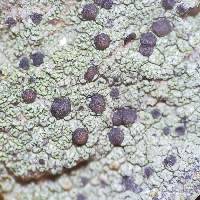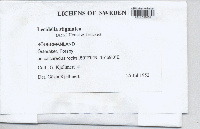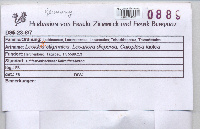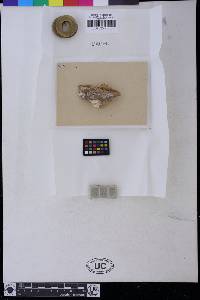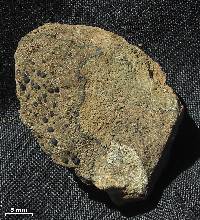
Consortium of Lichen Herbaria
- building a Global Consortium of Bryophytes and Lichens as keystones of cryptobiotic communities -
- Home
- Search
- Images
- Species Checklists
- US States: O-Z >
- US National Parks
- Central America
- South America
- US National Parks
- Southern Subpolar Region
|
|
|
|
Family: Lecanoraceae
[Bacidia arthoniza (Nyl.) Zahlbr., moreBuellia myriocarpa f. stigmatea (Schaer.) Stein, Buellia myriocarpa var. stigmatea (Körb.) H. Olivier, Buellia parasema var. stigmatea (Schaer.) Flagey, Buellia punctata var. stigmatea (Schaer.) Servít & Nádv., Lecidea lacus-crateris H. Magn., Lecidea micacea Körb., Lecidea prominula Borrer, Lecidea punctata var. stigmatea Schaer., Lecidea restricta Stirt., Lecidea stigmatea Ach., Lecidea stigmatea f. acrustacea (Müll. Arg.) H. Magn., Lecidea stigmatea f. armeniaca Szatala, Lecidea stigmatea f. diasemoides (Nyl.) Vain., Lecidea stigmatea f. egena (Kremp.) H. Magn., Lecidea stigmatea f. luxurians Vain., Lecidea stigmatea f. macra Vain., Lecidea stigmatea f. stigmatea Ach., Lecidea stigmatea f. subsequens (Nyl.) H. Magn., Lecidea subsequens Nyl., Lecidea subsequens f. paatsjokensis Vain., Lecidea subsequens f. subsequens Nyl., Lecidea vulgata Zahlbr., Lecidea vulgata var. subsequens (Nyl.) Zahlbr.] |
Nash, T.H., Ryan, B.D., Gries, C., Bungartz, F., (eds.) 2004. Lichen Flora of the Greater Sonoran Desert Region. Vol 2. Thallus: crustose, strongly rimose to areolate, thin, rarely more than 0.5 mm thick; prothallus: rarely present, grayish black surface: dirty white, gray, brownish gray to sometimes partly pale rusty, finely granulose, dull, without soredia or isidia Apothecia: sessile, strongly constricted at base, 0.8-2 mm in diam. disc: black to sometimes blackish brown (if shaded ?), plane to +convex when older, epruinose margin: distinct, thin, about 0.1 mm wide, becoming excluded exciple: greenish black to blackish green, rarely with a few algal cells parathecium: hyaline, without crystals epihymenium: bluish green, blackish green to olivaceous or reddish brown (if older or damaged ?) hymenium: hyaline, 60-85 µm tall, not inspersed; paraphyses: simple, rarely anastomosing or branched, slightly thickened apically hypothecium: hyaline to rarely brown (if damaged ?) asci: clavate, lecanoral, 8spored ascospores: hyaline, simple, ellipsoid to ovoid, 11-17 x 6-9 µm; wall: thick and smooth, not halonate Pycnidia: globular, semi-immersed, with Vobis-type III conidiophores conidia: filiform, +curved, 15-28 µm long Spot tests: thallus surface K+ yellow, C+ yellowish red to very rarely C-, KC+ yellowish red, P+ yellow Secondary metabolites: atranorin, chloroatranorin, hopane-6α,22diol and lichexanthone, rarely norlichexanthone. Substrate and ecology: on non-calciferous or calciferous rocks World distribution: temperate parts of Asia, Australasia, Europe, North and South America Sonoran distribution: widespread from low to high elevations in Arizona, southern California, Baja California and Chihuahua. |
|
|
|
Powered by Symbiota












